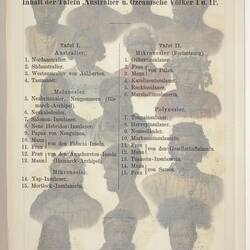Summary
Full colour lithograph of busts of people representing various Australian and Oceanic cultural groupings. From the Meyers Konversations-Lexikon (or Meyers Lexikon), Volume 6 printed by Bibliographic Institute in Leipzig, Germany, 1902-08. The publication was a major German encyclopedia that existed in various editions, and under several titles, from 1839 until 1984, when it merged with the Brockhaus encyclopedia.
Joseph Meyer (1796-1856), who had founded the publishing house Bibliographisches Institut in 1826, intended to issue a universal encyclopaedia meant for a broad public. The first part of das Grosse Conversations-Lexikon für die gebildeten Stände ('Great encyclopaedia for the educated classes') appeared in 1839. In contrast to its contemporaries, it contained maps and illustrations with the text. It took 16 years for the work to be completed in 1855. Ultimately numbering 52 volumes, it was the most comprehensive completed German encyclopedia of the 19th century. The complete set was reprinted 1858-59.
This lithograph is from the sixth edition, entitled Meyers Großes Konversations-Lexikon, published 1902-08. It had 20 volumes, and the largest sale of all Meyer editions, with 240,000 sets.
Physical Description
Two full colour lithographs attached by tape down the centre and featuring 30 images (15 on each page) of busts of people representing various Australian and Oceanic cultural groupings. Each person has been identified by a numbered key printed on transparent paper attached at the centre of the two illustrations. The illustrations are titled: 'Australier und Ozeanische Volker I' and 'Australier und Ozeanische Volker II' and the central key titled: 'Inhalt der Tafeln, Australier u. Ozeanische Volker I u. II.'
Significance
This illustration demonstrates the popular forms of scientific representation by European scientists in classifying Indigenous peoples into racial groupings.This is at a time, around the turn of the 20th century when scientific debate around Darwinism was also being influenced by other less scientific theories including eugenics and phrenology which all contributed to a white western social hierarchy which placed Indigenous peoples at the bottom of the social and intellectual pecking order. Of particular interest here is that the peoples are all from the Australasian and Oceanic regions, including Australian Aboriginal peoples from north, south, and west regions. Whilst these depictions are 'straight' and without stereotype or denigration, they still imply a primitive and less civilised nature which continued to fascinate white Western societies.
More Information
-
Collecting Areas
Migration & Cultural Diversity, Science & Measurement, Images & Image Making
-
Acquisition Information
Purchase
-
Printer & Publisher
Meyers Konversations-Lexikon, Leipzig, Saxony, Germany, 1902-1908
-
Inscriptions
Footer: Meyers Konv-Lexikon, 6 Aufl./Bibliogr. Institut in Leipzig/Zum Artikel Australien Page titles: 'Australier und Ozeanische Volker I' and 'Australier und Ozeanische Volker II'. Central key titled: 'Inhalt der Tafeln, Australier u. Ozeanische Volker I u. II.' Key: Plate 1. Australians: 1 Northern Australians; 2 South Australian; 3 Western Australians of Ashburton; 4 Tasmanians. Melanesians: 5 New Britain, New Britain (Bismarck Archipelago); 6 New Caledonians; 7 Solomon Islanders; 8 New Hebrides Islanders;10 Man from the Fiji Islands; 11 Wife of the Fiji Islands; 12 Wife of the Anchorite Islands (Bismarck Archipelago); 13 Man of the Anchorite Islands (Bismarck Archipelago). Micronesians:14 Yap Islanders; 15 Mortlock Islander. Plate 2. Micronesians (continued): 1 Gilbert Islanders; 2 Wife of Palau; 3 Man from Palau; 4 Caroline Islanders; 5 Ruck islanders; 6 Marshall Islander. Polynesians:7 Tonga Islanders; 8 Hervey Islander; 9 New Zealanders;10 Markesas Islands;11 Wife of the Society Islands; 12 Man of the Society Islands; 13 Taumotu Islander;14 Man of Samoa; 15 Woman from Samoa
-
Classification
-
Category
-
Discipline
-
Type of item
-
Overall Dimensions - Open
310 mm (Width), 244 mm (Height)
-
Keywords



